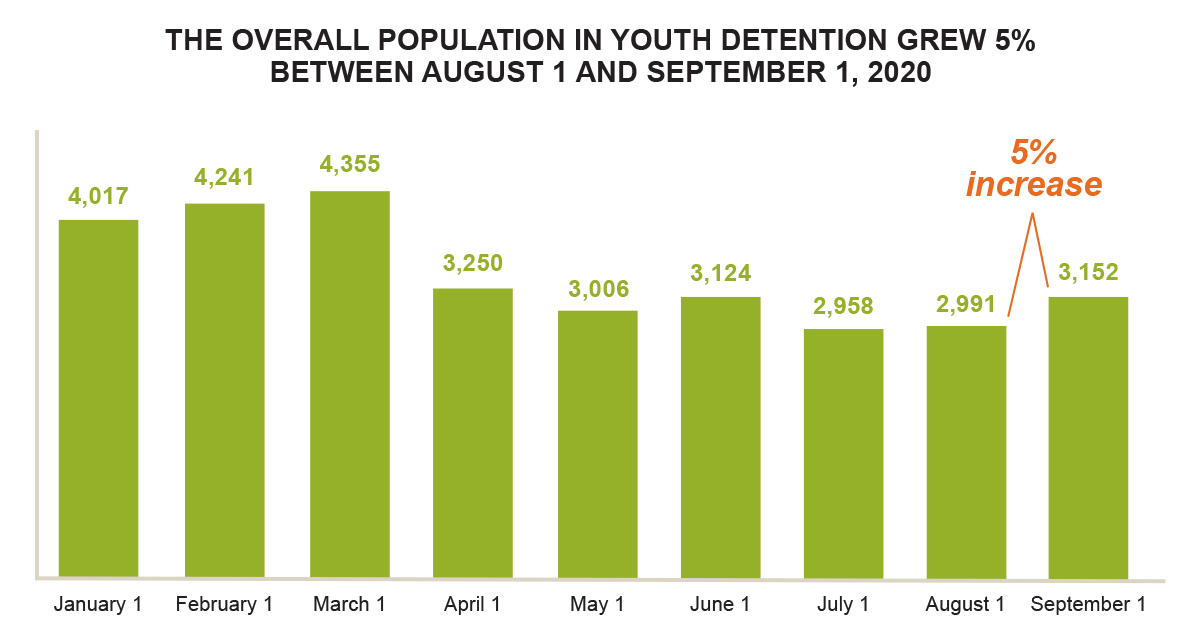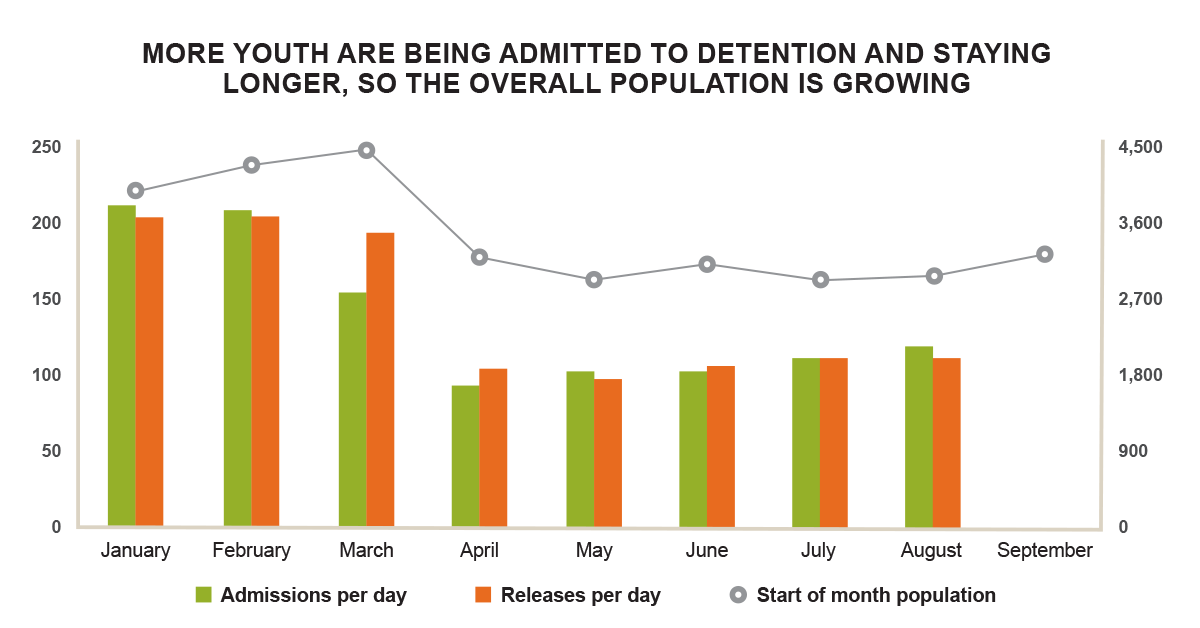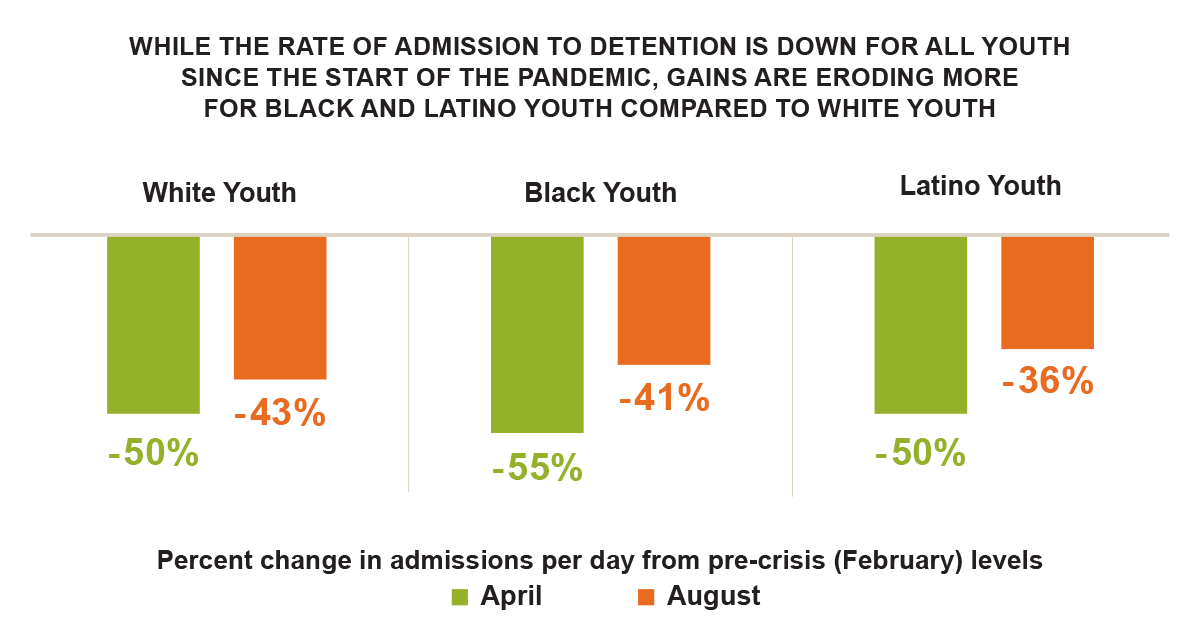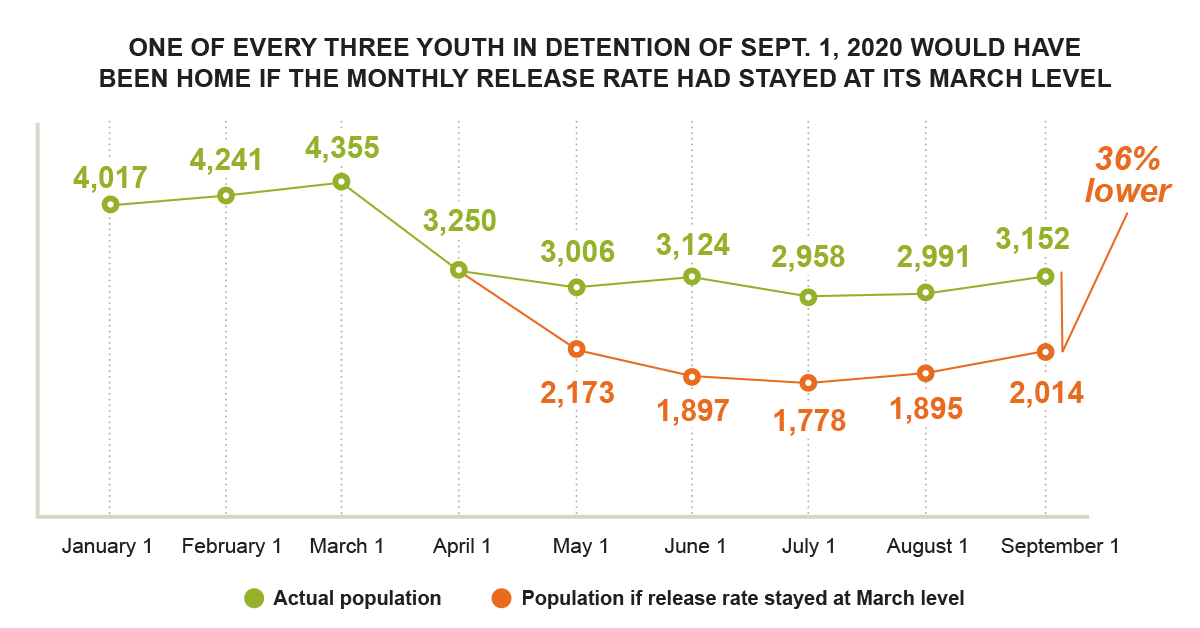Youth Detention Admissions Increase After Dramatic Decrease Early in Pandemic

A survey of youth justice agencies in 34 states — conducted by the Annie E. Casey Foundation — finds that admissions to youth detention centers are increasing, partially reversing dramatic declines in the first months of the pandemic and worsening racial and ethnic disparities.
The steepest drop in detention admissions occurred in the first month of the pandemic. But from April to August 2020, admissions have crept up. Although admissions per day are far below their pre-pandemic level, the upward trend is concerning. Throughout that five-month period, daily admissions were highest for Black youth and increasing the fastest for Latino youth compared to other racial and ethnic groups, including white youth.
Admissions is one factor in the number of youth in detention. The other is how quickly youth are released from detention. Higher admissions and a slower release rate meant that between August and September alone, the detention population increased by 5%.
“Juvenile justice agency leaders should be asking themselves what’s driving the increase in admissions to detention and longer lengths of stay in detention, especially for youth of color,” says Nate Balis, director of the Casey Foundation’s Juvenile Justice Strategy Group.
Detention centers are different than youth prisons or other residential placements where young people could be sentenced after being adjudicated delinquent. Rather, detention is a crucial early phase in the juvenile justice process. It is the point at which the courts decide whether to confine a young person pending their court hearing or while awaiting placement into a correctional or treatment facility rather than allowing the young person to remain at home.
Every year, an estimated 195,000 young people spend time in detention facilities nationwide, despite the negative effects of detention on young people — including likely deeper system involvement, separation from their families, health risks and a derailed education — and persistent racial disparities in who is detained.
Key Findings From the Juvenile Justice Survey
These trends are reflected in a Casey Foundation survey of jurisdictions around the country aimed at assessing the effects of the pandemic on juvenile justice systems through September 1, 2020.
The population rose by 8% for Black youth, 4% for Latino youth and 2% for white youth from August 1 to September 1.
The overall population in youth detention grew by 5% between August and September. Among jurisdictions that provided information disaggregated by race and ethnicity, Black youth fared worst (with an 8% increase in detention) compared to white and Latino youth, whose detention population grew 2% and 4%, respectively.
Two factors contribute to population gains: higher admissions and longer lengths of stay for youth already in detention. Between April and August, there has been a steady increase in admissions to detention per day. Also, young people were released from detention more slowly than they were prior to the pandemic.
Admissions per day are increasing, especially for youth of color.
In the first month of the pandemic, admissions per day fell more sharply among Black youth than white youth, 55% versus 50% respectively from February to April. But those early gains eroded from April to August. During the more recent period, admissions per day were closer to their pre-pandemic level for Black youth than they were for white youth, 41% below versus 43%.
These patterns have been even more adverse for Latino youth. Admissions per day for Latino youth fell 50% from February to April. But more than a quarter of that reduction was erased over the next four months. In August, the rate of admissions per day for Latino youth was 36% below the pre-pandemic level, the smallest decrease among the three racial and ethnic categories (Black, Latino and white) that have accounted for roughly 94% of admissions in every month of this survey.
Young people are being released from detention more slowly than they were prior to the pandemic.
The release rate (the percentage of all young people who were in detention at any point during a month who were released before the end of that month) is an indicator of how quickly young people are released from detention. The higher the release rate, the shorter the stays in detention, on average. Over the last three months, from June to August, the release rate hovered around 54%, down from 65% in March when the pandemic first hit, and close to 60% in the pre-pandemic months of January and February.
One of every three youths in detention on Sept. 1, 2020 would not have been in detention if the release rate had stayed at its March level.
Had the release rate in August stayed at the March rate of 65%, far fewer young people would have been held in detention on Sept. 1, 2020. The actual population as of Sept. 1 was 3,152; it would have been more than one-third lower — just 2,014 — if the March rate had been maintained.
Equitably increasing the release rate would substantially reduce the detained population, especially for youth of color.
Youth of color are released from detention more slowly than white youth, which is one of the reasons that youth of color are overrepresented in the detention population. Among jurisdictions that provided information disaggregated by race and ethnicity, the disparity in release rates has grown since the pandemic. In January and February, the release rate for youth of color was 7% lower than the rate for white youth. By August, the gap had widened to more than 12% lower. If all youth had been released in every post-pandemic month as quickly as white youth were released in March, then the population would have been 38% lower for white youth and 53% lower for non-white youth.
About the Survey
Working with the Pretrial Justice Institute and Empact Solutions, the Foundation first collected data just weeks after the coronavirus arrived in the United States.
The jurisdictions responding to the latest survey are home to roughly 30% of the U.S. youth population, ages 10 to 17. Most of the responding communities are involved in the Juvenile Detention Alternatives Initiative® (JDAI), a network of juvenile justice practitioners and other system stakeholders across the country working to build a better and more equitable youth justice system.
This survey, conducted from September 9 to 24 and covering the period from January 1 to September 1, is unique because it reports on data from hundreds of jurisdictions in close to real time. Information came from large urban counties and small rural courts, among a wide range of jurisdictions that collectively held 4,355 young people in secure detention on March 1, 2020. For perspective, approximately 15,660 young people were held in detention nationally on any given night, according to the most recent federal data from 2017.
There are no direct points of comparison that place this data in context. Available data on detention utilization from national surveys indicate that significant changes in detention typically accrue over several years.
This is a non-random sample, so it is not an accurate source from which to derive national estimates nor to determine statistically how representative this group of jurisdictions is of the nation as a whole. While there is overlap, the pool of jurisdictions replying to a monthly survey is unique to that survey alone, so monthly results cannot be directly compared. All of the data are self-reported by the participating jurisdictions.
Learn how juvenile justice leaders can reduce youth detention









